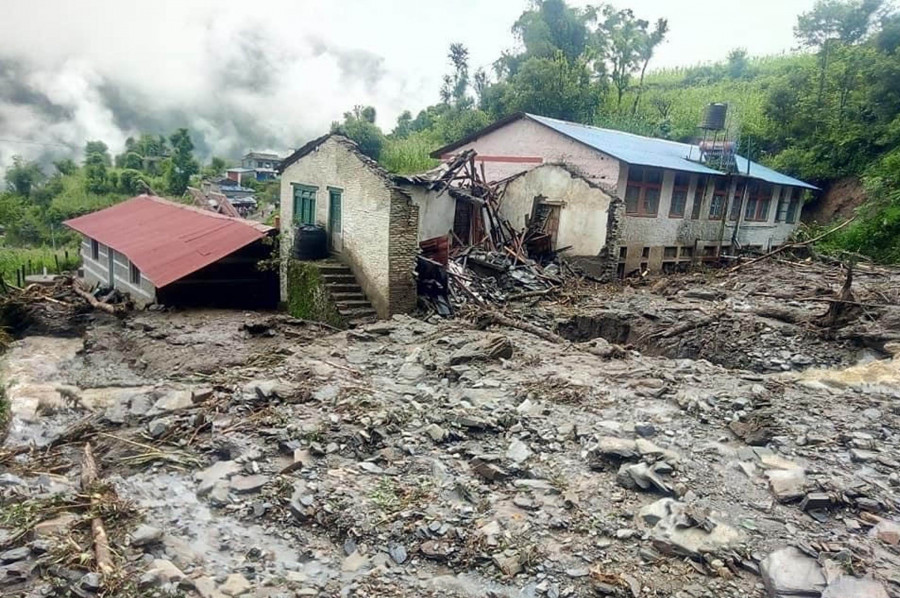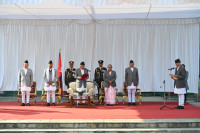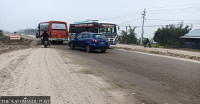National
Stuck at home after losing job to pandemic, Nepali migrants from districts where monsoon has wreaked havoc face a difficult road to recovery
Remittance money has always played a crucial role in disaster recovery. But Covid-19, which has left many migrant workers without work, has now made it much more challenging to recover from disasters.
Tsering Ngodup Lama
For the past three weeks, the only thing that has been on Hom Bahadur Thapa’s mind is a massive boulder sitting on a sloping hill, roughly 100 metres above his house. The boulder had come tumbling down the hill during a landslide on July 12.
In Thapa’s village of Niharey in Gulmi district, every year monsoon means heavy rainfall—and then rain-induced landslides. This year was devastating.
When local government officials came to inspect the landslide area, they told Thapa what he already knew—another landslide would send the boulder tumbling down, crashing into Thapa’s house.
“They said it was too risky for us to continue living in the house,” Thapa, 29, told the Post over the phone from his village in Gulmi. So Thapa took his family of five to a neighbour’s place in the same village.
A migrant worker, Thapa returned to Nepal on May 10 in the midst of the pandemic and lockdown.
“Had it not been for the pandemic, I would still be in Malaysia, working at a gloves manufacturing factory,” said Thapa. “Because of Covid-19, I couldn’t renew my passport, which left me with no option than to return.”
The only solace for Thapa is that he is with his family in these times of crises.
Hundreds of migrant workers who were either laid off or given unpaid leave were forced to return home paying hefty airfares. The one-way airfare on the Kuala Lumpur-Kathmandu flight cost each returnee Rs45,000, which they hardly earn in a month.
Thapa, however, was not much worried after he landed in Nepal after losing his job.
“But the landslide has completely changed everything,” said Thapa, the sole breadwinner in his family. “Now that I don’t have a steady source of income, how am I going to build a new house or arrange a safe place for my family to live in and feed them?”
Like Thapa, many migrant workers from villages of Sindhupalchok, Gulmi and Lamjung—where this year’s monsoon has caused extensive damage to life and property—have lost their jobs due to Covid-19.
Unemployed, many of them are likely to face huge challenges as they try to recover from the disaster.
Nepal has always been vulnerable to natural disasters. According to the United Nations Development Programme, globally, Nepal is ranked fourth, eleventh, and thirtieth in terms of vulnerability to climate change, earthquake, and flood risks, respectively.
This year, according to the Nepal Disaster Risk Reduction Portal, which compiles data on the country’s natural disasters, between June 12 (when the monsoon started) and July 12, landslides, floods and lightning strikes claimed 112 lives. Landslides alone claimed 76 people, the highest deaths recorded so far.
“Nepal continues to see devastating monsoons every year because apart from rescue operations and providing immediate relief materials for victims, we haven’t done anything that would help prevent such disasters,” said Madhukar Upadhya, a climate change adaptation expert. “The damage caused by water-induced disasters has also forced more people to seek foreign employment.”
Every year as monsoons wreak havoc in the country, the money that migrant workers like Thapa send back home helps their families cope with and move on from the damage caused by disasters.
How important a role remittance plays in disaster recovery was very evident in 2015, the year Nepal experienced devastating earthquakes. That year, Nepal received $6.6 billion in remittance money. The amount was 20.9 percent more than in 2014.
According to Nepal Rastra Bank, the significant increase in remittance inflow was because of migrant workers sending money to rebuild houses damaged by the earthquakes and for their families to cover basic household expenditures.
But the Covid-19 pandemic is having an all-round effect—on disaster recovery to remittance earnings.
According to a report published by the Asian Development Bank on August 3, due to the global economic slump caused by Covid-19, Nepal could see a 28.7 percent drop in remittance in 2020.
“Without continuous remittance flows, remittance-dependent households can fall into poverty or have difficulty meeting basic essential needs, as well as access to education and health services. Loan repayment is another challenge for remittance recipient households,” the Manila-based multilateral funding agency said in its report.
In Thapa’s family, the first one to leave for foreign employment was his father.
“For many years, my father worked as a security guard in Chennai, India. The money he sent home helped cover our family’s expenses,” said Thapa. “When I turned 22, I told my father, who was already in his 50s, to leave his job and return to Nepal.”
When the father came back, Thapa went to Malaysia.
“It was my turn to take care of the family,” said Thapa. “From Malaysia, I could manage to send home anywhere between Rs 15,000 and Rs 20,000 a month.”
Four years after working in Malaysia, Thapa managed to save enough money to renovate his old house and add one more room.
“I spent a big chunk of my savings on the house,” he said. “Now I don’t have savings. Nor do I have a house where my family can feel safe.”
In Lamjung’s Tarapu Pallotari village, after a few days of incessant rainfall, the first landslide occurred on the night of July 20. Two days later, on July 22, another landslide struck the village. One of the houses that were buried in the landslide was Milan Asami’s.
“The landslide occurred in the morning and nobody was hurt,” said Asami, 25.
Like Thapa, Asami too is a returnee migrant worker. He returned to Nepal on March 5 from Saudi Arabia, where he worked at an air cooler servicing company.
“My plan was to stay at home for a month and then head for Kuwait to work at a company where a few of my friends were employed,” said Asami. “Just a few weeks after my arrival, the lockdown happened and I have been stuck here since.”
Asami’s first stint as a foreign migrant worker was in India, at a slaughterhouse in Aligarh in the state of Uttar Pradesh. He was only 16 then.
“Had it not been for foreign employment, our family would still be living in poverty,” said Asami. “Ever since my brother, who is now in Dubai, and I have been old enough to work, we have both been relying on foreign employment to support our family.”
After working in India for four years, Asami returned to Nepal, got his passport and flew to Qatar. Four years ago, with the money the Asami brothers had saved, the family had built the house, which was buried in last month’s landslide.
“We spent around Rs 600,000 for the house. It was all our savings, and all of it is gone now,” said Asami. “To make matters worse, my brother has been laid off by his employers, whose business suffered immensely due to Covid-19. As soon as international flights resume, he will return to Nepal too.”
Remittance is a mainstay of Nepal’s economy. In 2019, Nepali migrant workers sent home $8.1 billion, accounting for 27.3 percent of the country’s gross domestic product, according to the World Bank.
The money earned by Nepalis abroad, especially in the Persian Gulf and Malaysia, has been instrumental in the economic empowerment of rural households like those of Thapa and Asami.
For many like Thapa and Asami, this time, things have taken a turn for the worse as there was a double blow—Covid-19 and monsoon-induced disasters.
Both Asami and Thapa are aware that building a new house is out of the question.
“To build a house you need money, which we don’t have,” said Asami, who has already started building a temporary shelter out of wood and corrugated sheets for his family to move in. “I hope this pandemic gets over soon so I can go abroad to work and send money home so we can move on.”
For Thapa, not a day goes by without worrying about arranging a safe shelter for his family and finding a job for himself so that he can continue to provide for his family.
“If I don’t find a steady source of income soon, I’ll have no option but to move my family into our own house,” said Thapa.
Thapa knows very well that the big boulder sitting on the sloping hill 100 metres above his house can come tumbling down any time. But it’s a risk he may have no choice but to take, he said.




 7.12°C Kathmandu
7.12°C Kathmandu















